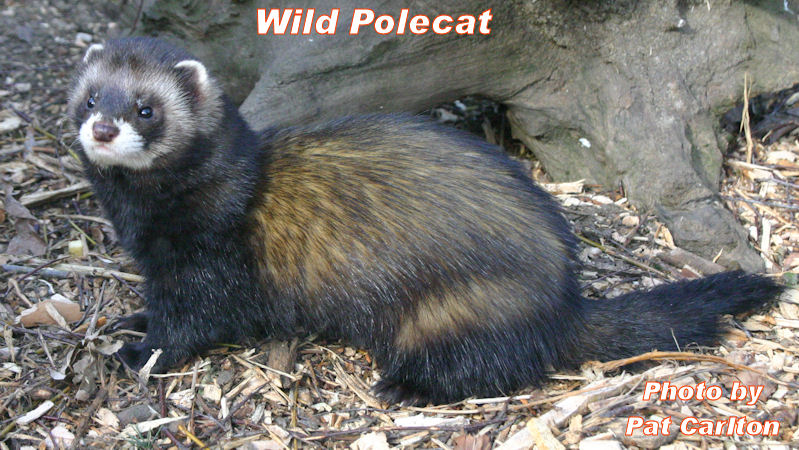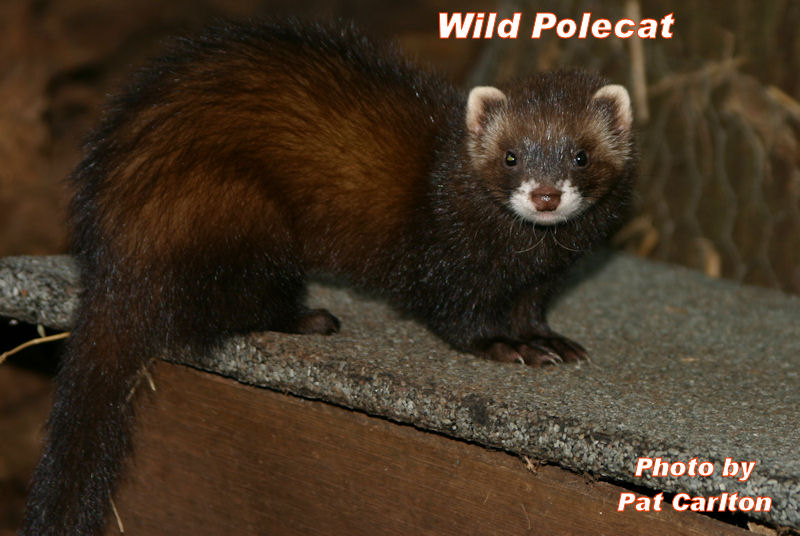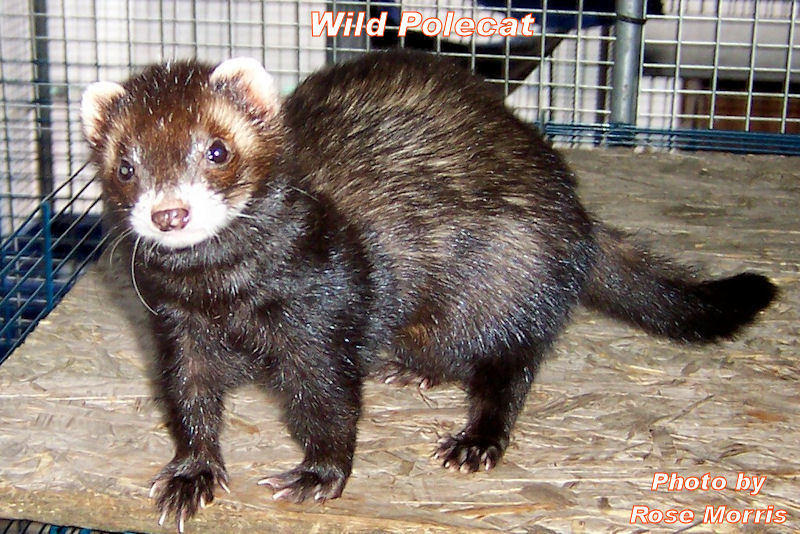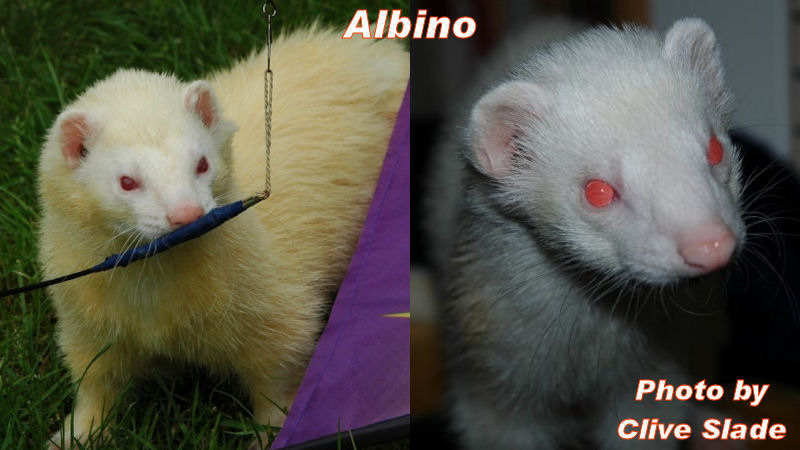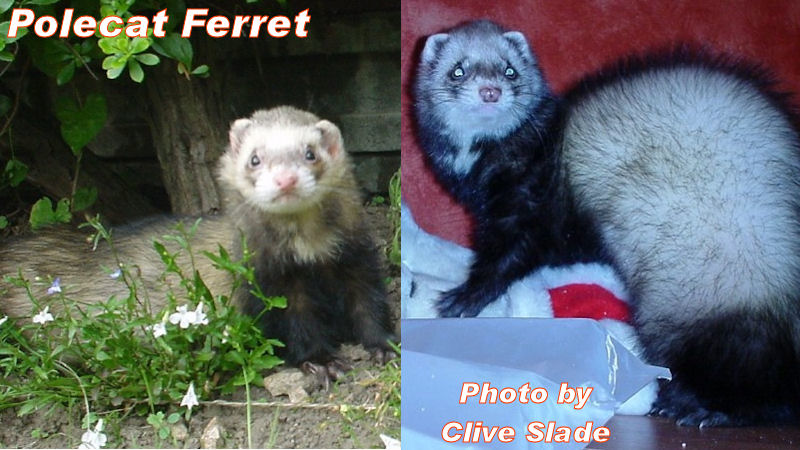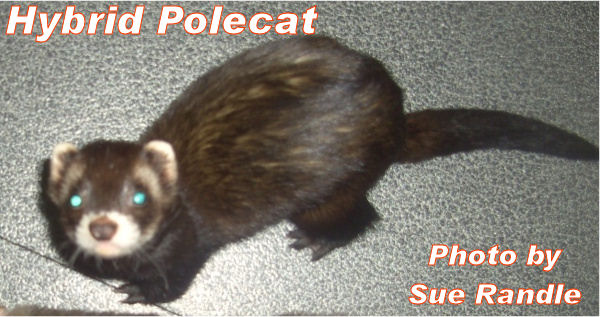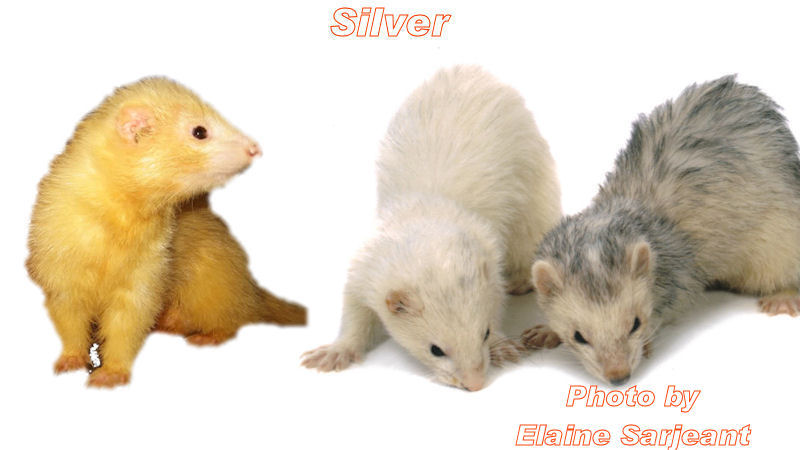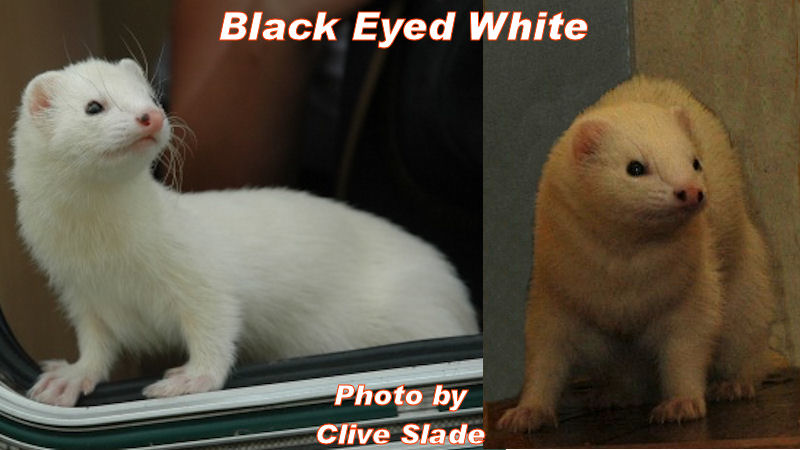Page Updated 21/03/10
|
Common Questions
What about pregnant women and ferrets? Don't they smell and what about neutering/spaying? Do Ferrets have a homing instinct? Do ferrets prefer hot or cold temperatures? How do I tell if it is a Jill or a Hob?
Ferrets are members of the order Carnivora and the family Mustalidae, which also includes polecats, minks, weasels, otters, stoats, pine martins, badgers and wolverines. The ferret has been domesticated since approximately 400 BC. It is descended from the European polecat and was originally used for pest control, hunting rabbits and also its fur. For various reasons the favoured colour was the albino and these were bred to the point that unlike most animals, where an albino baby is a rare event, in the case of the ferret it is now the dominant gene. There is a lot of speculation about why this was done and one of the more likely reasons is that when hunting in the past they would use both a ferret and a bird of prey. The ferret would be sent down the burrow to flush the rabbit and the bird of prey then captured the rabbit and brought it back. White ferrets were more easily visible and so less likely to be confused with the rabbit, by the bird of prey.
An un-neutered wild Polecat Hob Despite all being members of the same family the only animals a ferret can breed with are another ferret and the wild polecat. A polecat is actually a wild animal and when crossed with a ferret, the dark colouring, plus the bandits mask are introduced. Unless someone is referring to a wild animal, most of the time when they talk about “having a polecat”, it is in fact more than likely a ferret that in some time in its distant past, was crossed with a polecat.
An un-neutered wild Polecat Jill Most of the time it is nearly impossible to tell a hybrid ferret and a wild polecat apart without DNA tests. However to the very observant the wild Polecat has its eyes closer together and when you talk to them their ears continually move around. The good news is, unlike their much larger family member the Mink, they are not naturally aggressive to humans.
A neutered wild Polecat Jill
Ferrets coats come in several different colours and patterns. The colour of a ferret may also change depending on their age and the season, as they have summer and winter coats. Another factor which can affect the colour is whether the ferret is neutered, as most un-neutered ferrets will have a yellow to ginger hue to their fur. Albino — white with pink eyes. They may also have a faint yellowing even if neutered.
Whole Hob and Neutered Hob Albino Ferrets Polecat — range from brown to black with a cream undercoat. The normally have the classic robbers mask over the eyes.
Neutered Hob and Neutered Jill Polecat Ferrets Hybrid Polecat — Almost black, these are normally early generation Ferret / Polecat crosses
Neutered hybrid Ferret Silver — has Silver/Grey coloured hairs, and has dark eyes.
Entire hob, and 2 neutered hobs. All classed as Silvers, but you can clearly see how broad the differences are. Dark (Black) eyed white (DEW/BEW) — This is a pure white ferret like the albino, but with dark eyes. DEW‘s are actually a silver ferret with out any grey hairs, and many Silvers will become white as they age.
Neutered Jill. Dark Eyed White. Sandy — A light brown to ginger colour. They come with a variety of makings, often having light coloured bibs and feet.
Neutered Jill and Neutered Hob. Sandy.
Un-neutered female ferrets (Jills), un-like most other animals, must mate when they come into season. If they do not, they become prone to several medical conditions which can lead to various infections and may ultimately kill them. Ferrets also tend to have fairly large litters of Kits, often around 10, and sometimes more. Then to really make things bad they can have two litters of kits a year. This means that some un-thinking owners will give the kits to anyone who will take them, just to get rid of them. When Ferret Kits are old enough to be re-homed, like most baby animals, the Kits are cute, small and fluffy. This makes them attractive to lots of people, who really do not know anything about them. They often get them as pets on a whim, especially as they are often “free”. When the new owner gets a Ferret Kit, they do not realise that, just like a puppy, they have very sharp teeth and like to test them on everything. They take about 6 months to grow out of this. Unfortunately at about 6 months they become adults and start to get the “powerful” scent, often associated with ferrets. So they now have a 6 month old bundle of teeth which has started to smell. Often by this point the owner has become bored, fed up or scared of the kit. If they are reasonably responsible the owner may take it to a Ferret Rescue or try to find someone else to take care of it. The less lucky ferrets are just left in their cage and forgotten about. Occasionally owners are cruel and may try to hurt the ferret back when it nips. Some people just release unwanted ferrets into the wild. Unfortunately, ferrets cannot live in the wild in the UK. They are not able to find food and get various parasites, which will cause infection and in a relatively short time kill the ferret. That is assuming it does not get killed by a dog, run over or its curiosity takes it somewhere dangerous. The lucky ones are found by nice people, and arrangements are made for them to be rescued.
While ferrets have become a fairly common pet in the last couple of decades, there has been very little scientific testing about peoples allergic reactions to them carried out. Ferrets are “fur-bearing” animals meaning they do not produce significant amounts of dander that “hair bearing” animals such as cats, most dog breeds and people do. So while you could be highly allergic to some other animal, you may have no problems at all with ferrets, which is why ferrets are classed by some people as “hypo-allergenic” pets. Many ferret owners can not have any other pet because of their allergies Where people do show allergic reactions, and studies have been performed, they found there are a number of factors that could cause the allergy, but fairly often, it can actually be an outside influence, such as a perfume in a shampoo used to bathe the animal, or a reaction to the bedding the animal is kept in, especially if it is kept on Hay, Straw or Wood. Where it has been discovered to be directly connected to the ferret, various proteins have been found to cause the allergy. A blood protein, called albumin, appears to be the important one. Albumin, while mainly found in the blood, may also be found in urine, faeces, saliva and fur. If you think you might be allergic to your ferret, it is worth isolating the external factors first. Contrary to bad advice often given, ferrets should not be kept in straw, hay or sawdust as not only can it harbour parasites, it irritates their sinuses and can cause several medical issues for the ferret, along with possibly being the cause of your allergy. It is far better to use cloth bedding, such as fleece or cotton blankets. Please do not use towels or knitted blankets that have loops in the material that ferrets can get their claws caught in. If you change their litter tray daily, and wash the bedding regularly, for 2 or more ferrets, this needs to be twice a week, this will reduce the chances of traces of Albumin building up, reducing your chances of having any allergic reaction. With their habitat sorted, it is time to look at your routine for your ferrets personal hygiene, or more specifically, the Shampoo that is used to wash them. Several people have reported that the proprietary Ferret Shampoos commonly available make them totally allergic to their ferrets. A lot of people mistakenly bath their ferrets regularly in the belief that it reduces their smell, but in fact, regular bathing of ferrets is actually likely to make them smell worse, as their bodies work a lot harder to replace the oils removed by washing. Regular changing of the bedding has a far better effect of keeping your ferret clean than bathing and the natural oils n their fur help to stop them getting dirty. On the odd occasion your ferret does manage to get particularly dirty, and really does need a bath, try using a well known baby shampoo. Sometimes, having carried out all the above, you still find you are having an allergic reaction. If this is the case, you may still be able to find a cure as it could be a reaction to an intact male, or the ferrets he has lived with. To prove this, try having some contact with someone who only has females or neutered males, and see if you still react to them. Very often, once they are neutered, and a few weeks have passed for the hormones to die down, you will find that you no longer have any reaction. Neutered Ferrets can therefore be a fine alternative to the more common pets for people with allergies and asthma. What about pregnant women and ferrets? A health concern for pregnant women is toxoplasmosis which may be passed to her through animal faeces , especially cats faeces. For the majority of people it is nothing to worry about, unless you are pregnant, have a very young child, or have a weakened immune system. Toxoplasmosis is very dangerous to a human foetus in the first stages of development, it may also be dangerous to infants and toddlers and it's a concern for those who are HIV+. In the last couple of years, due to laboratory tests, the information regarding ferrets and Toxoplasmosis has changed from “nothing to worry about” to “proceed with caution”. Dr. Bruce Williams, DVM, says: “Toxoplasmosis has been reported twice in ferrets. Ferrets will not shed the toxoplasma organism to the extent that cats do, but if they are exposed to cat faeces, they may contract the disease and shed very low amounts of oocysts.” “Here's the bottom line. Because of the devastating effects that Toxoplasmosis can have on a developing human foetus in the first trimester you don't want to take ANY chance at all on exposing a pregnant woman to Toxoplasmosis. So someone in the household who isn't pregnant should inherit all litter box duties for the next nine months. Actually a pregnant woman probably stands a higher chance of getting Toxoplasmosis from poorly cooked beef.” The doctor goes on to say — “if she's a carnivore — better get used to well-done steaks.... ” So although Ferrets may under specific circumstances carry this and you will need to pass the job of cleaning the cage to someone else, you can at least carry on playing with your ferrets. Do ferrets smell and what about neutering/spaying? The normal reason for a ferret having an over whelming smell is either that it has not been neutered, or that the cage and bedding are not being cleaned often enough. Normally both of these are also detectable by a visible yellow/brownish colour to the fur and a greasy coat e.g. an albino‘s would be more a yellow colour, rather than white. Keeping their bedding washed and clean will reduce both the oil and its smell. Having the ferret neutered not only removes the smell, but also has a calming effect on the ferret as well. Ferrets also have a scent gland near their tail and when scared, or occasionally when very over excited, they can release a scent a bit like a skunk. Fortunately, unlike the skunk, this smell dissipates very quickly. Female ferrets really should be neutered for their own health, as un-like most animals, when a female ferret comes into season she does not come out of it until she actually mates. If they have not found a mate within a couple of years they can suffer from oestrogen induced anaemia, which leads to a lingering, unpleasant death. It is also possible as a temporary solution, to get a jill that is in heat injected with what has become known as the “Jill Jab”. This will bring them out of season but as it is possible for ferrets to have 2 litters of Kits in a year, you will usually need to have them jabbed a second time unless you go on and get them neutered before they come back into season.
Ferrets, like any other animal that is looked after and handled, very quickly learns that it is not good to “bite the hand that feeds them”. Both dogs & cats bite if not loved and handled each day and ferrets are exactly the same. Ferrets are very intelligent and learn very quickly, both good and bad habits. They use their mouths as we would use our hands, so if they want to move something, they will use their mouths. Your reaction to this ‘mouthing’ will condition the ferret — if you are calm and consistent, telling the ferret ‘no’ firmly when they do this they will learn that your skin is less tough than theirs! If you snatch your hand away or respond with anger or violence then you will condition them in a negative way to human skin. ‘Nip training’ is common sense and can easily be achieved.
No, we do not sell ferrets. If you have come to this website looking to give a ferret a home then please visit the links page for a list of rescue centres, which are likely to be full of ferrets looking for a good home, or join one of the Ferret forums listed for more information of Ferret Rescues in your area
Ferrets are not a wild animal, they are a domestic pet and have been domesticated for about 2500 years. They cannot survive in the wild in this country and have no natural homing instinct, therefore they need to always be kept in a controlled environment e.g. a run, a spacious cage and when out and about, on a lead. They react very badly to both fleas and ticks, usually getting severe anaemia, often leading to infection and death. Even assuming that they manage to feed themselves most will only live for about 5 or 6 weeks. Do Ferrets have a homing instinct? As you can see from “Do they live in the wild”, the answer is no. Ferrets are descended from the European Polecat, because of the way this animal would continually move from one burrow to the next as and when the food ran out, they have no need for a permanent ‘home”. Most ferrets found in the wild are a pet which may have escaped and does not know how to get back to where it lived.
Ferrets are obligate carnivores, meaning they are designed to eat whole prey items, which includes all parts of the killed animal including the fur/feathers and bones. You cannot just feed it a breast of chicken every day and expect to have a healthy, loving ferret. The natural diet of the ferrets ancestor, the polecat, would include smaller mammals and reptiles like rats, rabbits, voles, mice, slugs, snails, frogs and lizards. They would also eat birds if they could get them. Ferrets imprint very early in their lives on the foods they will and will not eat, so changing the diet of a ferret can be a long slow process. Most are fed on dried food for convenience. There are a lot of “complete foods” for ferrets on the market, meaning that they should provide all the nutrients and protein a ferret will need. There are various ferret treats and supplements available, which while not really necessary, as the food should already contain everything they need, are very useful for ferret encouragement and training. Unfortunately a lot of treats sold for ferrets are actually very bad for them, so it is very important that they are given in moderation. Always bear in mind that they are little thieves so if you are eating they will happily try to share it, regardless of whether or not it is good for them. Always make sure ferrets have a continual supply of food and water, they have a very high metabolism and they need to eat little and often. As a very rough guide, ferrets will eat between 5% and 10% of their body weight of dried food per day.
This varies, anywhere between 8 to 12 years and sometimes longer. Do ferrets prefer hot or cold temperatures? Ferrets do not have a very efficient body cooling system and react badly and quickly to too much heat. Death from heat stroke is a very real possibility. Ferrets ideally like to be below about 20C (70F). Heat exhaustion can occur when sun shines into a room through a glass window, or directly onto the roof of a hutch. In the summer it is very important to make sure that they can cool down and since they cannot sweat simply blowing a fan over them is not enough, the air blowing over them must actually be cooler than 20C to cool them. Things like placing a freezer block in a towel in the cage and changing it regularly, a bowl of fresh cool water to paddle in and spraying a mist of water onto their coats are all ways to help keep them cool but require regular human intervention. Even in the UK several people have portable Air Conditioning units for their ferrets for the summer. Cold is less of an issue. As long as they have somewhere snug, dry and sheltered to curl up in ferrets seem to have no trouble keeping warm in cold weather. How do I tell if it is a Jill or a Hob? In general male ferrets will be much larger than female ferrets. Both male and females have nipples so this is not an indicator of either sex. Intact male ferrets will have testes and will also have what appears to be a ‘belly button’ or a tuft of fur some way up their underside, this is their penis. Neutered males and young males will have the same ‘belly button’ but will not have visible testes. Adult Weight: 1 to 5.5lbs (500g to 2.5kg). Can vary by up to 40% dependent on the time of the year. Adult Size: 17” to 24” (44 to 60cm) including their tail. Males generally can be twice as large as the female. Average Lifespan: between 8 and 12 years (older have been known). Respiratory Rate: 30-40 breaths per minute. Heart Rate: 220-250 beats per minute. Rectal Temperature: Average 38.8C (101.8F). Range 37.8 to 40C (100 to 104F). Sexing: Ano-genital distance of male at least twice that of female. Environment: Optimum 15 to 20C (60 to 70F). Heat prostration likely at 32C 90F. Teeth: Incisors 3/3, canines 1/1, premolars 3/3, molars 1/2. Supernumerary incisors common. Toes: 5 on each foot. Slight webbing between toes. Nipples: 8 (male and female). Vertebrae: Cervical (neck)7, Thoracic (ribs)14 or 15, Lumbar (lower back)6, Sacral (pelvis) 3, Caudal/Coccygeal (tail) 14-18. 14 or 15 pairs of ribs. Other Anatomy: No caecum, appendix and male prostate gland. Sweat glands not well developed. Sexual Maturity: 6-9 months, usually the spring following birth. Season Signs: Female has swollen vulva, male has swollen testes. Both smell. Gestation: Average 42 days. (Range 38 to 44 days; at 45 days kits die.) Litters per year: Two possible Nesting: Starts building 10 to12 days before birth. Litter size: 2 to17 (average 8, norm. 6 to 9) - more in first litter of season than in second. Birth weight: 0.5oz (5 to 15g). Deciduous Teeth: Begin to erupt at 10 to14 days. Canines: 47 to 52 days. Eyes/Ears Open: 21 to 37 days. Fur: Almost naked at birth, some by 9 days, good woolly coat by 4 to 5 weeks. Out of nest: First ventures usually 3 to 4 weeks. Weaning age: 6 to 8 weeks. Weaning weight: 10.5 to 17.5 oz (300 to 500g). Attain Adult Weight: 6 months. |
Website and contents © Clive and Suzanne Slade 2010 © ....Contact webmaster@lazy-ferret.co.uk
